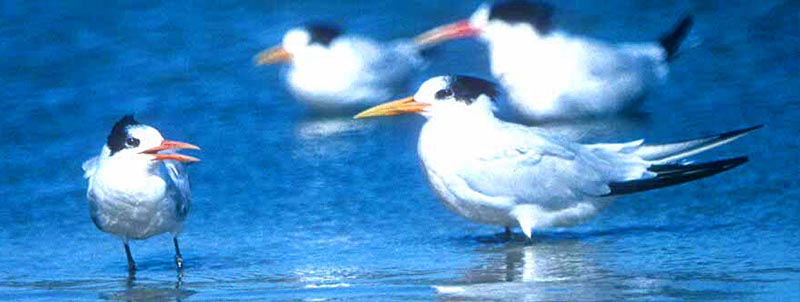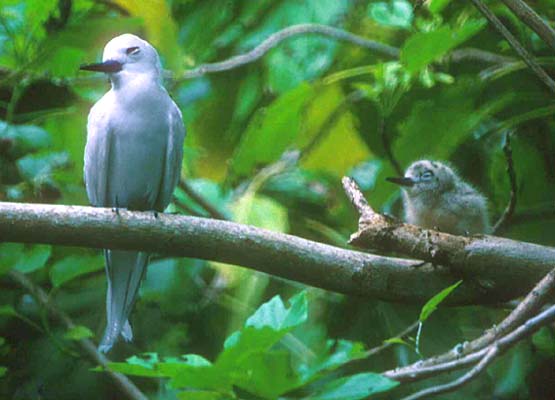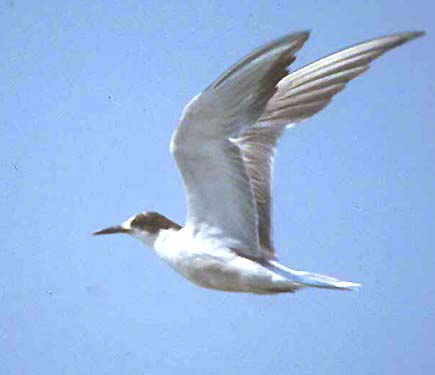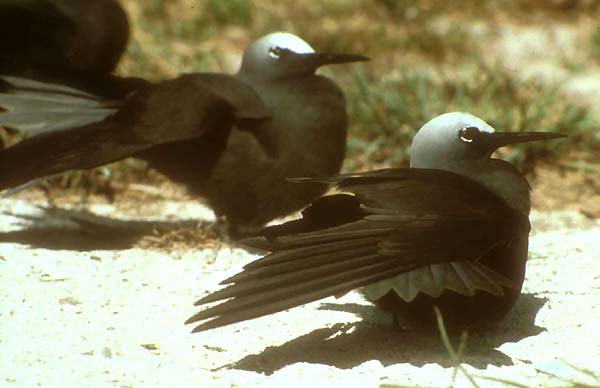

TERNS Sternidae
|
||
 Terns
are a distinctive group of arial fish feeders. They are closely related
to gulls (Laridae) but are more specialized in terms of nesting habitat,
diet and foraging methods, and their morphology reflects these specializations
(Gochfeld & Burger 1996). Almost two-thirds of the species are "typical"
terns in the genus Sterna, represented here by the mid-sized Elegant
Tern (group top of page) of the Pacific Coast of California
and west Mexico. It is one of six species of "crested" terns found along
tropical and temperate coastlines around the globe. All the "crested terns"
nest in very dense colonies with incubating adults just a body length apart.
Despite what you may see in field guides, there is quite a bit of variation
in bill (and leg) color in young Elegant Terns, as can be seen in the photo.
This species colonized southern California within the last half-century
and is now common in summer and fall north to Monterey Bay. Terns
are a distinctive group of arial fish feeders. They are closely related
to gulls (Laridae) but are more specialized in terms of nesting habitat,
diet and foraging methods, and their morphology reflects these specializations
(Gochfeld & Burger 1996). Almost two-thirds of the species are "typical"
terns in the genus Sterna, represented here by the mid-sized Elegant
Tern (group top of page) of the Pacific Coast of California
and west Mexico. It is one of six species of "crested" terns found along
tropical and temperate coastlines around the globe. All the "crested terns"
nest in very dense colonies with incubating adults just a body length apart.
Despite what you may see in field guides, there is quite a bit of variation
in bill (and leg) color in young Elegant Terns, as can be seen in the photo.
This species colonized southern California within the last half-century
and is now common in summer and fall north to Monterey Bay.
Another group are a half-dozen "noddies & relatives" in three genera that are restricted to tropical oceans. Among them is the beautiful White Tern (left or above left), shown here at its nest site on the island of Cousin in the Seychelles. The adult dozes near a just-hatched chick. These terns make no nest but lay a single egg in the fork of tree branch and incubate it there until the fluffy baby hatches. Terns are closely related to gulls and skimmers; indeed, much recent literature follows Sibley & Monroe (1990) in considering them simply a tribe (not even a subfamily) of an expanded Laridae which includes gulls, terns, jaegers, and skimmers. I prefer the traditional approach that considers terns to constitute a family, an approach used in the on-going Handbook of the Birds of the World series (Gochfeld & Burger 1996). This approach emphasizes their distinctiveness while recognizing that they evolved from larid-like ancestors. |
||
 While
about half of the species of terns in the world are primarily birds of
tropical oceans and coastlines, small Sterna terns occur in a wide
range of habitats. Some are indeed tropical, like this White-cheeked
Tern (right) of the western Indian Ocean, ranging north into
the Red Sea and Persian Gulf. In basic plumage (as shown here) many of
the species are very similar. All of these species have comparatively similar
body shapes evolved to dive for fish from the air. All have swift and graceful
flight styles. While
about half of the species of terns in the world are primarily birds of
tropical oceans and coastlines, small Sterna terns occur in a wide
range of habitats. Some are indeed tropical, like this White-cheeked
Tern (right) of the western Indian Ocean, ranging north into
the Red Sea and Persian Gulf. In basic plumage (as shown here) many of
the species are very similar. All of these species have comparatively similar
body shapes evolved to dive for fish from the air. All have swift and graceful
flight styles.
There are huge differences in the ranges of these small-sized Sterna terns. Common Tern S. hirundo is a widespread breeder in the Northern Hemisphere and then migrates in huge numbers to the Southern Hemisphere in winter. Arctic Tern S. paradisaea is renowned for its exceptionally long migration route from the high Arctic to Antarctic winter grounds. There are other migratory species that nest around the Bering Sea (Aleutian Tern S. aleutica) and on the Antarctic Peninsula (Antarctic Tern S. vittata). Many of these are mostly pelagic species but others (e.g., Little Tern S. albifrons in the Old World, Least Tern S. antillarum in the New World) follow rivers and wetlands to nest well inland. |
||
A very unique species that forages in the cold Peru Current off western
South America is Inca Tern (below left). It is generally
placed in its own genus (Larosterna) because of its remarkable plumage
and because of its distinctive breeding behavior. It nests in deep crevices
and small caves along the arid coastline; I photographed the one shown
here with a flash inside one of those small caves in coastal Peru.
|
||
|
A few terns are mostly interior waterbirds, and among them are the three "marsh terns" in the genus Chlidonias. They, too, are highly migratory. Species that migrate long distances can produce vagrants far from normal migration routes. One example is this lovely breeding-plumaged White-winged Tern (below left). It foraged over the Arcata wastewater ponds for several weeks in summer 1996 where it represented the first record for California and, indeed, the first record for the western United States. Three years later a one-year-old White-winged Tern appeared on Elkhorn Slough in my home county (Monterey Co.) for the second state record. It also stayed over a month, and was thus observed by hundreds of eager birders.
|
||
 Although
most of the world's terns are white or pale gray or both, there are dark
brown or blackish colored species, including Inca Tern (featured above).
Best known, though, are the three species of "noddy terns" (genus Anous)
that forage offshore in tropical oceans. They breed in large concentrations;
American birders are very familiar with the huge Brown Noddy A. stolidus
colony in the Dry Tortugas, Florida. A species that prefers to nest colonially
in trees and small bushes on tiny islands is Black Noddy (left).
Shown here are just two of several dozen Black Noddies that had just returned
in the late afternoon to Heron Island on the Great Barrier Reef. They had
been fishing all day offshore and now were drying their wings before flying
up into their nest trees. The bungalows here are scattered among the Casuarina
trees used by the nesting noddies, and the din of them squabbling all night
long is incredible. Although
most of the world's terns are white or pale gray or both, there are dark
brown or blackish colored species, including Inca Tern (featured above).
Best known, though, are the three species of "noddy terns" (genus Anous)
that forage offshore in tropical oceans. They breed in large concentrations;
American birders are very familiar with the huge Brown Noddy A. stolidus
colony in the Dry Tortugas, Florida. A species that prefers to nest colonially
in trees and small bushes on tiny islands is Black Noddy (left).
Shown here are just two of several dozen Black Noddies that had just returned
in the late afternoon to Heron Island on the Great Barrier Reef. They had
been fishing all day offshore and now were drying their wings before flying
up into their nest trees. The bungalows here are scattered among the Casuarina
trees used by the nesting noddies, and the din of them squabbling all night
long is incredible. |
||
| Photos: The flock of Elegant Terns
Sterna elegans was at the Salinas River mouth, Monterey Co., California,
on 11 Sep 1994. The adult and baby White Tern
Gygis alba were at a nest site on Cousin I., Seychelles, in Nov 1992.
The basic plumaged White-cheeked Tern Sterna
repressa was following the incoming fishing fleet at Fujairah, United
Arab Emirates, in March 2001. The adult Inca Tern
Larosterna
inca was at islets off the Paracas Peninsula, Peru, in June 1986. The
subadult Sooty Tern Sterna fuscata
was thousands of miles offshore in the eastern tropical Pacific in Oct
1989. The adult White-winged Tern
Chlidonias leucopterus was California's first record at Arcata marsh,
Humboldt Co., on 25 June 1996. The fledgling Caspian
Tern Sterna caspia was at the breeding colony at the
Salinas R. mouth, Monterey Co., California, on 17 Jun 2004. The drying
adult Black Noddies Anous minutus were
on Heron I., Great Barrier Reef, Australia, on 25 Nov 1983. All
photos © 2004 Don Roberson; all rights reserved.
Bibliographic note There is no "family book" per se although terns are included in numerous texts which cover gulls and relatives. The account by Gochfeld & Burger (1996) in the Handbook of the Birds of the World series is an excellent introduction. There are several recent books on tern identification but none covers all the species. I found Olsen & Larsson (1995) to be quite good for the 23 species that it covered although it seemed better for the Old World than the New. I understand that there is another tern i.d. book of which the late Claudia Wilds was a co-author. I have not yet seen it, nor have I found it yet available for sale. It should be quite good, though, given Claudia's excellence in all things having to do with identification. Literature cited: Au, D.W.K., and R.L. Pitman. 1986. Seabird interactions with dolphin and tuna in the eastern tropical Pacific. Condor 88: 304-317. |